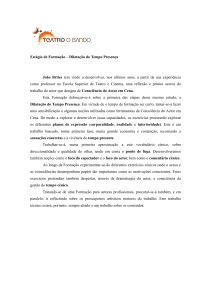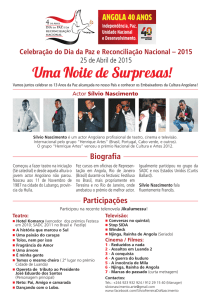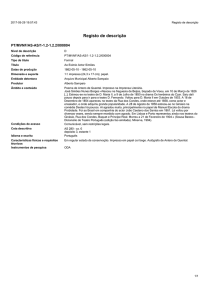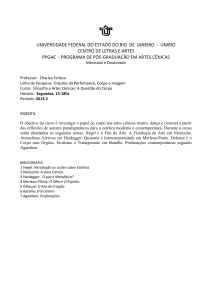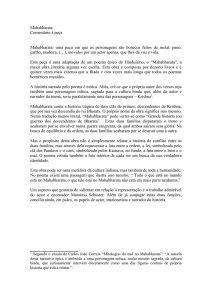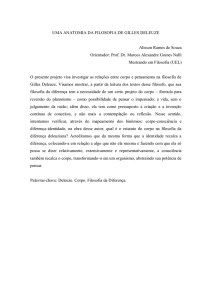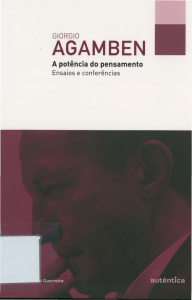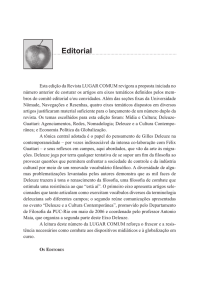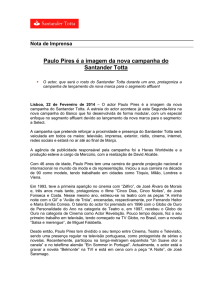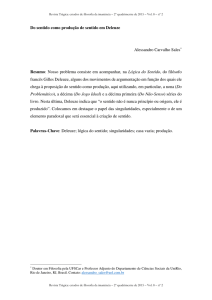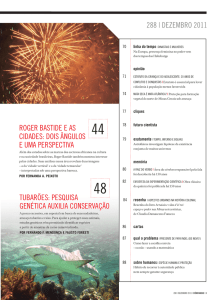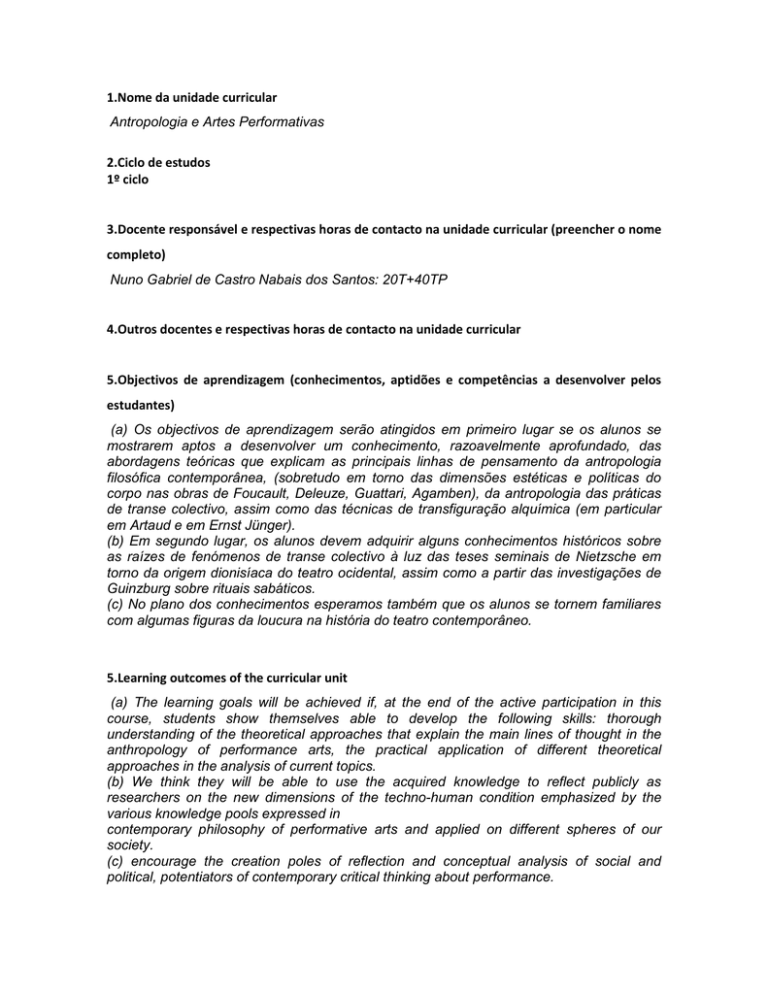
1.Nome da unidade curricular
Antropologia e Artes Performativas
2.Ciclo de estudos
1º ciclo
3.Docente responsável e respectivas horas de contacto na unidade curricular (preencher o nome
completo)
Nuno Gabriel de Castro Nabais dos Santos: 20T+40TP
4.Outros docentes e respectivas horas de contacto na unidade curricular
5.Objectivos de aprendizagem (conhecimentos, aptidões e competências a desenvolver pelos
estudantes)
(a) Os objectivos de aprendizagem serão atingidos em primeiro lugar se os alunos se
mostrarem aptos a desenvolver um conhecimento, razoavelmente aprofundado, das
abordagens teóricas que explicam as principais linhas de pensamento da antropologia
filosófica contemporânea, (sobretudo em torno das dimensões estéticas e políticas do
corpo nas obras de Foucault, Deleuze, Guattari, Agamben), da antropologia das práticas
de transe colectivo, assim como das técnicas de transfiguração alquímica (em particular
em Artaud e em Ernst Jünger).
(b) Em segundo lugar, os alunos devem adquirir alguns conhecimentos históricos sobre
as raízes de fenómenos de transe colectivo à luz das teses seminais de Nietzsche em
torno da origem dionisíaca do teatro ocidental, assim como a partir das investigações de
Guinzburg sobre rituais sabáticos.
(c) No plano dos conhecimentos esperamos também que os alunos se tornem familiares
com algumas figuras da loucura na história do teatro contemporâneo.
5.Learning outcomes of the curricular unit
(a) The learning goals will be achieved if, at the end of the active participation in this
course, students show themselves able to develop the following skills: thorough
understanding of the theoretical approaches that explain the main lines of thought in the
anthropology of performance arts, the practical application of different theoretical
approaches in the analysis of current topics.
(b) We think they will be able to use the acquired knowledge to reflect publicly as
researchers on the new dimensions of the techno-human condition emphasized by the
various knowledge pools expressed in
contemporary philosophy of performative arts and applied on different spheres of our
society.
(c) encourage the creation poles of reflection and conceptual analysis of social and
political, potentiators of contemporary critical thinking about performance.
6.Conteúdos programáticos
I. Arqueologias do transe colectivo.
1. Duas raízes do transe colectivo no ocidente. As Bacantes e o Sabat. As leituras de
Nietzsche e de Guinzburg.
2. Rituais xamânicos. Eficácia simbólica do transe: a teatralidade do sagrado. Roger
Bastide.
II. Estranhamentos involuntários do corpo-próprio.
1. O corpo-próprio
como corpo estranho. A psicose segundo Gisela Pankow.
2. O corpo-próprio
como corpo perdido. Nudez enquanto experiência política. Giorgio Agamben
3. O corpo dócil. Disciplina e biopolítica segundo Foucault.
III Estranhamentos involuntários de alma.
1. Formas de possessão em África e na Ásia. A antropologia de EvansPritchard.
2. Figuras da loucura no teatro do século XX. De Strindberg a Thomas Bernhard.
IV. Técnicas de transfiguração.
1. Drogas e Embriaguez: intensificação alquímica da sensibilidade. De Artaud a Ernst
Jünger.
2. Devir-criança, devir-mulher, devir-animal. Deleuze e Guattari.
6.Syllabus
I. Archaeologies of the collective trance.
1. Two roots of the collective trance in the West . The Bacchae and the Sabbath . The
readings of Nietzsche and
Ginzburg .
2 . Shamanic rituals. Symbolic efficacy of trance : the theatricality of the sacred. Roger
Bastide.
II . Involuntary strangeness of the body-self.
1. The body-self
as a foreign body. Psychosis according to Gisela Pankow .
2 . The body-self
as a lost body. Nude as political experience . Giorgio Agamben
3 . The docile body. Discipline and biopolitics in Foucault.
III. Involuntary strangeness of the soul .
1. Forms of possession in Africa and Asia. The Anthropology according to EvansPritchard.
2 . Figures of Madness in twentieth-century
theater. Strindberg and Thomas Bernhard.
IV. Techniques of transfiguration.
1. Drugs and Drunkenness: alchemical intensification of sensitivity . Artaud and Ernst
Jünger.
2 . Becoming-child, becoming-woman, becoming-animal. Deleuze and Guattari.
7.Demonstração da coerência dos conteúdos programáticos com os objectivos de aprendizagem
da unidade curricular
Desde Stanislavski que a teoria do actor está fundada sobre uma psicologia da máscara.
A personagem é apropriada pelo actor como um fingimento, como um duplo dele próprio,
que se vem sobrepor ao mundo psicológico do actor sem por esse facto o dissipar. As
personagens a representar foram por isso muitas vezes pensadas por Stanislavski como
“arquétipos” universais, disponíveis nas profundezas inconscientes de qualquer actor.
Representar pôde ser assim ser descrito como um processo paralelo ao sonho, ao
mecanismo de deixar vir à consciência conteúdos recalcados, de tornar reais outros “eus”.
Uma das mais importantes transformações da teoria do teatro ocorrida no sec.XX é
aquela que se reclama da tradição que vem de Nietzsche e da sua arqueologia do
nascimento da tragédia a partir do espírito dionisíaco. Essa tradição consiste na recusa de
um teatro da máscara e da personagem. Nas suas origens cultuais, dionisíacas, o
trabalho do actor é pensado a partir de um estranhamento fundamental.
7.Demonstration of the syllabus coherence with the curricular unit's objectives
Since Stanislavski theory of the actor is a psychology founded on the mask. The character
is appropriated by the actor as a double of himself, who has overcome the psychological
world of the actor without thereby to dissipate him. The characters represented were so
often thought by Stanislavski as "archetypes", available in the unconscious depths of any
actor. Representing might be well be described as a parallel process to the dream, to
make real the other "selves". One of the most important transformations of the theory
occurred in the XX century theater comes from Nietzsche and his archeology of the Birth
of Tragedy from the Dionysian spirit. This tradition is a refusal of a theater mask and
character. In their cultural, Dionysian origins, the work of the actor is thought as a
fundamental estrangement.
8.Metodologias de ensino (avaliação incluída)
As aulas são maioritariamente expositivas. Os textos fundamentais da bibliografia estão
sempre presentes nas exposições – quer em regime de leitura colectiva, quer como
sustentação pontual das teses formuladas pelo professor. É possível projectar alguns
documentários previstos sobre práticas de possessão em África, rituais xamânicos ou
experimentações contemporâneas de mutações colectivas em artes performativas. Como
método de avaliação existem dois elementos escritos (teste e monografia a combinar com
o docente) e três possibilidades de criação em artes performativas (comentário crítico de
um espectáculo em cena, escrita de um guião de um trabalho performativo, construção de
um trabalho de performance). Qualquer uma destas cinco modalidades de avaliação
implicará sempre uma entrevista final.
8.Teaching methodologies (including evaluation)
Classes are mostly expository. The bibliography of key texts are always present in
expositions under the right of collective reading, either as timely support of the theses
formulated by the teacher. it is possible to project provided some documentaries about
practices of possession in Africa, shamanic rituals and contemporary experimentation
collective mutations in performing arts. As evaluation method there are two elements
written (test and monograph to combine with the teacher) and three possibilities of creation
in the performing arts (critical review of a performance on stage, writing a script for a
performative work, building a performance work). Any of these five evaluation methods
always involve a final interview.
9.Demonstração da coerência das metodologias de ensino com os objectivos de aprendizagem
da unidade curricular
Desde os estudos sobre o papel dos rituais xamânicos na construção das representações
do corpo-próprio em sociedades arcaicas, sem escrita, até às investigações sobre
técnicas de transe colectivo praticadas em religiões animistas, passando pela
reconstituição das raízes cultuais femininas de algumas das mais importantes formas de
resistência à racionalização das liturgias cristãs na história das práticas de feitiçaria desde
o final da Idade Média, a antropologia, a sociologia, a etnografia, a história, a psicologia
têm vindo pôr em evidência formas de subjectivação que não decorrem de construção de
identidades (individuais ou colectivas), nem de transfigurações miméticas determinadas
por arquétipos culturais ou universais. Daí o convite a acompanhar as obras de Evans
Pritchard sobre formas de possessão em África e na Ásia, ou os estudos de Roger
Bastide sobre rituais xamânicos no Brasil negro. Esse acompanhamento estava previsto
ser feito com a projecção de documentários, em paralelo com a leitura das obras
principais desses antropólogos (o que não foi possível fazer como consequência do
processo disciplinar que foi aplicado ao docente). No plano da antropologia filosófica, o
método expositivo impunha-se para dar os primeiros passos nas leituras de Foucault,
Deleuze e Agamben, os quais representam actualmente os mais relevantes contributos
para o pensamento dessas subjectividades colectivas mutantes. Por pluralidade de
perspectivas adoptadas nesta cadeira obriga a um grande trabalho de introdução teórica a
cada um dos autores considerados, e a uma leitura cuidadosa das suas obras de
referência. No entanto, há a consciência de que muitos alunos terão dificuldade em
penetrar nos enredos mais especulativos desses autores. Para não os excluir do processo
de avaliação, foram considerados outros regimes (mais práticos) de construção de
objectos que possam ser classificados.
9.Demonstration of the coherence between the teaching methodologies and the learning
outcomes
Since studies on the role of shamanic rituals in constructing representations of the body
esteem
in archaic societies without writing, to the investigation of techniques for collective trance
practiced in animistic religions, through reconstitution of female cultic roots of some of the
most important forms resistance to the rationalization of Christian liturgies in the history of
witchcraft practices since the late Middle Ages, anthropology, sociology, ethnography,
history, psychology has highlighted forms of subjectivity that are not based on identity
construction (individual or collective), nor mimetic transfiguration determined by cultural or
universal archetypes. Hence the invitation to accompany the works of Evans Pritchard on
forms of possession in Africa and Asia, or the studies of Roger Bastide on shamanistic
rituals in Brazil black . This monitoring was planned to be done with the screening of
documentaries , in parallel with the reading of the major works of these anthropologists
(which was not possible to do as a result of the disciplinary process that was applied to the
teacher). On the level of philosophical anthropology, the lecture method was required to
take the first steps in the readings of Foucault, Deleuze and Agamben, which currently
represent the most relevant contributions to the thinking of these mutants collective
subjectivities. On the plurality of perspectives adopted in this chair requires substantial
theoretical work to each of the authors considered introduction, and a careful reading of
their works of reference. However, there is an awareness that many students have
difficulty in penetrating the most speculative plots of these authors. Not to exclude the
evaluation process were considered as other schemes to build objects that can be sorted
(more practical).
10.Bibliografia
Agamben, Giorgio, Nudez, trad.Miguel Serras Pereira, Lisboa, Relógio d’Água, 2011.
Bastide, Roger, Le Rêve, la transe et la folie (1972), Paris, Éditions Le Seuil, «PointEssais», 2003 (reedição).
Deleuze, Gilles e Guattari, Felix, [1980] Mil Planaltos. Capitalismo e Esquizofrenia II, trad.
Rafael Godinho, Lisboa, Assírio & Alvim, 2008.
Evans-Pritchard, Edward [1937]. Witchcraft, Oracles, and Magic Among the Azande,
abridged with an introduction by Eva Gillies. Oxford, Clarendon Press, 1976.
Foucault, Michel, Vigiar e Punir. Nascimento da Prisão, trad. Raquel Ramalhete,
Petrópolis, Editora Vozes, 1987.
Guinzburg, Carlo, História Nocturna. Uma decifração do Sabat, Trad. Nilson Moulin
Louzada, Lisboa, Relógio d’Água, 1995.
Lewis, Ioan M, Ecstatic Religion: An Anthropological Study of Spirit Possession and
Shamanism. Harmondsworth, Penguin Books, 1971.
Rouget, G. Music and Trance: A Theory of the Relations Between Music and Possession .
Chicago, University of Chicago Press, 1985.

